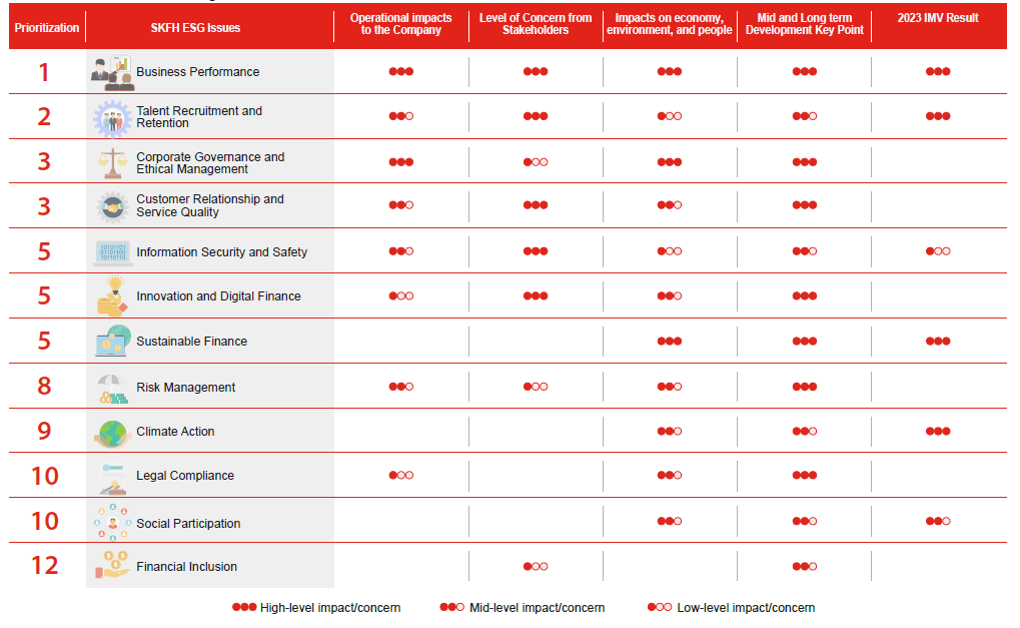- Home
- Sustainability Strategy
- Materiality Assessment
SDGs
Materiality Assessment
To understand the connection between issues of concern to stakeholders and the Company’s long-termvalues, we identify material issues in accordance with GRI reporting standards. We also established related performance indicators to manage the material economic, environmental, and social issues we identified and included them into work items of SKFH for the current year to manage corporate sustainability.
Collect Sustainability Issues
Referred to international sustainable development trends, material issues in domestic and international financial and insurance industries, and the latest regulations and guidelines. Compiled 20 sustainability themes related to SKFH based on SKFH’s strategic development directions.
Identify Stakeholders
Distributed questionnaires internally to identify individuals or groups who are or may be affected by the Company's economic activities. Identified eight major stakeholders: shareholders and investors, employees, customers, government agencies, suppliers, media, communities, non-profit/non-governmental organizations..
Survey Stakeholders' Level of Concern
Gather stakeholders' level of concern about SKFH's sustainability issues. A total of 348 questionnaires were collected.
Evaluate the Impact on Company's Operations
Distributed operational impact assessment questionnaires to executives and employees of SKFH and subsidiaries. Evaluated the impact of various sustainability issues on the Company's revenue, costs, and risks. A total of 876 questionnaires were collected.
Analyze Impacts on Economy, Environment, and People
Introduced impact assessment tools and invited the Executive Secretaries of the Corporate Sustainability Committee of SKFH and subsidiaries to jointly assess the linkage between economic, environmental, and societal impacts (including human rights) and the Company's sustainability issues. Conducted positive and negative impact assessments for each impact event and defined the value chain stage where the impact occurred.
Analyze and Prioritize Material Issues
Integrated the impacts of sustainability issues on business operations and on external economy, environment, and people, and took into account the level of concern from external stakeholders to prioritize material issues.
Verify the Material Issues
Presented the prioritization of material issues to the management committee of SKFH for discussion and decision-making on the prioritization by senior executives. The results of the prioritization of material issues were verified by the third-party assurance provider and submitted to the Board of Directors.
Impact Assessment Process
In assessing the impacts on the economy, environment, and society, SKFH adopts methodologies developed by the Value Balancing Alliance (VBA) and Harvard Business School's "Impact-Weighted Accounts." These approaches enable a quantitative analysis of the economic, environmental, and social dimensions based on impact and the identification of SKFH's material issues. By applying these international standards and guidelines, SKFH identifies 18 positive and negative impacts, comprising 6 economic, 4 environmental, and 8 related to human rights. Through the evaluation conducted by 21 employees, considering the severity, scope of influence, irreversibility, and likelihood of occurrence for actual and potential impacts, 10 significant impacts and sustainability issues were identified. In addition, SKFH also adopted a monetized impact assessment approach to identify material issues with impact valuation. The monetized analysis of impact valuation suggests that "Business Performance," "Supplier Sustainability Management,""Talent Recruitment and Retention," and "Sustainable Finance" are the most significant issues. They primarily generate positive impacts, including gross value added (GVA), procurement demand to drive the relationship between industrial supply and demand, giving wages that take into account the quality of life, investment and financing to drive the supply and demand relationship of the industrial chain, and investment and financing to create employment opportunities in the industrial chain. Negative impacts are mainly derived from supplier environmental externalities and derived industry chain environmental externalities.

Material Issues and Prioritization
Through the assessment results of the impacts of various sustainability issues on business operations, as well as the impact on the external environment, society, and people, and summarizing the level of stakeholders’ concern, 12 major issues were identified, namely: Business Performance, Risk Management, Corporate Governance and Ethical Management, Sustainable Finance, Information Security and Privacy, Customer Relationship and Service Quality, Innovation and Digital Finance, Legal Compliance, Climate Action, Talent Recruitment and Retention, Financial Inclusion, and Social Participation. We also examine the significance of each issue from the perspectives of external regulations and sustainability trends, the results of the monetization shock assessment, and the World Economic Forum's Global Emerging Risks. The order of materiality issues as shown in the following table:


